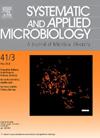Halosimplex amylolyticum sp. nov., Halosimplex halobium sp. nov., Halosimplex marinum sp. nov., Halosimplex rarum sp. nov., Halovenus amylolytica sp. nov., Halovenus halobia sp. nov., and Halovenus marina sp. nov., halophilic archaea isolated from a marine tidal flat, a marine solar saltern, three coarse sea salts, and two saline lakes
IF 4.2
2区 生物学
Q2 BIOTECHNOLOGY & APPLIED MICROBIOLOGY
引用次数: 0
Abstract
Seven novel halophilic archaeal strains DYHT-AS-1T, GDY60T, TS25T, XH63T, SHR40T, SYNS179T, and ZY30T were isolated from tidal flat, saline lakes, marine solar saltern and coarse sea salts from different regions of China. Metagenomic and amplicon analyses indicated that the abundance of these seven strains in respective habitats was low. Phylogenetic and comparative genomic analyses indicated that strains DYHT-AS-1T, GDY60T, TS25T, and XH63T formed a tight cluster with Halosimplex species, exhibiting high 16S rRNA gene sequence similarity (90.4–99.4 %). The ANI, dDDH, and AAI values among these four strains and current Halosimplex species were 80.8–92.3 %, 24.5–53.3 %, and 77.8–91.5 %, respectively. Strains SHR40T, SYNS179T, and ZY30T were related to Halovenus species, with 16S rRNA gene sequence similarities ranging from 88.8 % to 98.4 %. The ANI, dDDH, and AAI values among these three strains and current Halovenus species were 69.9–77.8 %, 19.4–21.5 %, and 62.1–78.1 %, respectively. These values are significantly lower than the thresholds for species demarcation. The optimal growth conditions for these seven strains in terms of NaCl, MgCl₂, temperature, and pH were 3.1–3.4 M, 0.05–0.5 M, 35–40 °C, and 6.5–7.5, respectively. According to phenotypic differences in nutrition, biochemical activity, and antibiotic sensitivity, these seven strains can be distinguished from their related species. Based on the above results, strains DYHT-AS-1T, GDY60T, TS25T, and XH63T represent four new species of the genus Halosimplex, and strains SHR40T, SYNS179T, and ZY30T represent three novel species of the genus Halovenus.
从海洋潮滩、海洋太阳盐沼、三种粗海盐和两个盐湖中分离出的嗜盐古菌,分别是:嗜盐单孢菌、嗜盐单孢菌、海洋单孢菌、稀有嗜盐单孢菌、嗜盐单孢菌、嗜盐单孢菌、嗜盐单孢菌和嗜盐单孢菌
从中国不同地区的潮滩、盐湖、海洋太阳盐沼和粗海盐中分离到7株新的嗜盐古细菌DYHT-AS-1T、GDY60T、TS25T、XH63T、SHR40T、SYNS179T和ZY30T。宏基因组和扩增子分析表明,这7种菌株在各自生境的丰度较低。系统发育和比较基因组分析表明,菌株DYHT-AS-1T、GDY60T、TS25T和XH63T与Halosimplex属形成紧密的集群,16S rRNA基因序列相似性较高(90.4 ~ 99.4%)。4株菌株与现种的ANI、dDDH和AAI值分别为80.8% ~ 92.3%、24.5 ~ 53.3%和77.8 ~ 91.5%。菌株SHR40T、SYNS179T和ZY30T与Halovenus属有亲缘关系,其16S rRNA基因序列相似性在88.8% ~ 98.4%之间。3种菌株与现种的ANI、dDDH和AAI值分别为69.9 ~ 77.8%、19.4 ~ 21.5%和62.1 ~ 78.1%。这些值明显低于物种划分的阈值。7株菌株的最佳生长条件(NaCl、MgCl 2、温度、pH)分别为3.1 ~ 3.4 M、0.05 ~ 0.5 M、35 ~ 40℃和6.5 ~ 7.5。根据营养、生化活性和抗生素敏感性的表型差异,可以将这7株菌株与其亲缘种区分开来。基于以上结果,菌株DYHT-AS-1T、GDY60T、TS25T和XH63T代表Halosimplex属的4个新种,菌株SHR40T、SYNS179T和ZY30T代表Halosimplex属的3个新种。
本文章由计算机程序翻译,如有差异,请以英文原文为准。
求助全文
约1分钟内获得全文
求助全文
来源期刊

Systematic and applied microbiology
生物-生物工程与应用微生物
CiteScore
7.50
自引率
5.90%
发文量
57
审稿时长
22 days
期刊介绍:
Systematic and Applied Microbiology deals with various aspects of microbial diversity and systematics of prokaryotes. It focuses on Bacteria and Archaea; eukaryotic microorganisms will only be considered in rare cases. The journal perceives a broad understanding of microbial diversity and encourages the submission of manuscripts from the following branches of microbiology:
 求助内容:
求助内容: 应助结果提醒方式:
应助结果提醒方式:


